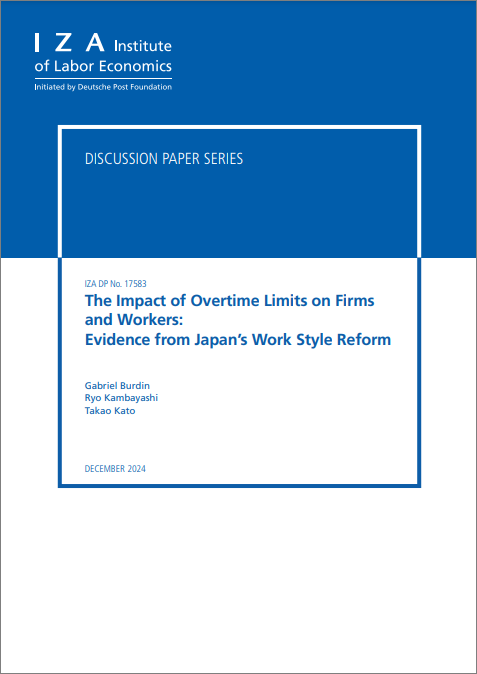
□ 2018년 일본의 근로방식 개혁(Work Style Reform, WSR)이 초과근로 제한을 통해 기업과 근로자에게 미친 영향을 분석한 연구임. 일본은 장시간 근로 문화와 성별 임금 격차 문제를 해결하기 위해 법적으로 초과근로 시간을 연간 360시간으로 제한했음. 연구는 차별적 차이 분석(difference-in-differences)을 활용해 개혁이 초과근로 시간, 임금, 고용 형태 및 근로자 만족도에 미친 영향을 조사함. 일본의 WSR은 기업 수준에서는 초과근로 시간이 월평균 5시간(-25%) 감소하는 효과를 보였으며, 개인 수준에서도 비슷한 결과를 나타냄
□ 초과근로 제한은 총 임금을 2% 감소시키는 결과를 낳았지만, 시간당 임금은 변동이 없었음. 남성 근로자는 초과근로가 줄어든 대신 무급 초과근로로 대체했으며, 이는 삶과 여가 만족도의 개선으로 이어지지 않음. 반면, 여성 근로자는 초과근로 감소로 인해 삶과 여가 만족도가 향상됨. 이 개혁은 여성의 정규직 전환을 촉진해 고용의 질을 높이는 데 긍정적인 영향을 미침. 성별에 따라 서로 다른 효과가 나타난 점이 중요한 특징으로 평가됨
□ 개혁은 기업에서 초과근로의 분포를 압축하고, 임금 구조를 조정하며, 고용 형태를 변화시키는 데 영향을 미침. 특히, 여성 근로자의 정규직 비율이 증가하고 비정규직이 감소하면서 노동시장 내 성별 평등을 증진함. 그러나 남성 근로자의 경우 무급 초과근로가 늘어나는 부작용이 확인되어 추가적인 정책 보완이 필요함. 이는 장시간 근로 문화와 관련된 구조적 문제를 해결하는 데 있어 중요한 시사점을 제공함. 개혁은 단순한 초과근로 감소 이상의 효과를 가지며, 성별과 고용 형태를 고려한 종합적인 접근이 요구됨
□ 결론적으로, 일본의 WSR은 근로시간과 임금 구조를 개선하고 여성 근로자의 고용의 질을 향상시키는 데 긍정적인 영향을 미침. 하지만 남성 근로자와 여성 근로자 간의 상이한 결과는 추가적인 정책적 대응과 후속 연구의 필요성을 보여줌. 이 연구는 초과근로 제한이 노동시장 내 성평등 촉진 및 근로자 삶의 질 향상에 어떻게 기여할 수 있는지에 대한 중요한 통찰을 제공함. 따라서, 일본의 경험은 다른 국가에서도 참고할 만한 정책적 교훈으로 활용될 수 있음
목차
Title page
Contents
Abstract 3
1. Introduction 4
2. Institutional context and Japan's Work Style Reform 8
3. Data 9
4. Establishment-Level Responses 11
4.1. Research Design: Establishment-Level Difference-in-Differences 11
4.2. Effects on Working Hours 12
4.3. Effects on Wages 14
4.4. Effects on Employment 15
4.5. Heterogeneous Effects 16
4.6. Robustness 17
5. Additional Evidence: Individual-Level Impacts 18
5.1. Individual-Level Difference-in-Differences 19
5.2. Self-Reported Working Time: Paid and Unpaid Overtime 19
5.3. Effects on Workers' Subjective Well-Being 21
5.4. Robustness Checks and Additional Results 21
6. Conclusions 24
References 25
Online Appendix A. Supplementary Tables and Figures 46
Table 1. DiD estimates: Working Hours 38
Table 2. DiD estimates: Log Wages 39
Table 3. DiD estimates: Employment 40
Table 4. DiD estimates: Workforce Composition 40
Table 5. DiD estimates: Self-Reported (Weekly) Working Hours 42
Table 6. DiD estimates: Subjective Well-Being 44
Table 7. DiD estimates: Perceived Work Intensification and Time Use 45
Figure 1. Evolution of Overtime Hours per Worker 30
Figure 2. Event-Study Analysis: Hours 31
Figure 3. Event-Study Analysis: Wages 32
Figure 4. Event-study Analysis: Employment 33
Figure 5. Heterogeneous Effects: Gender 34
Figure 6. Event-Study Analysis: Self-Reported Overtime and Subjective Well-Being 35
Figure 7. Event-Study Analysis: Self-Reported Overtime and Subjective Well-Being by Gender 36
Figure 8. Event-Study Analysis: Paid vs. Unpaid Overtime Hours by Gender 37
Table A1. Who Supplies Overtime Hours? 46
Table A2. Estimation Samples: Descriptive Statistics 47
Table A3. DiD estimates: Anatomy of Overtime Hours Changes Within Establishments 48
Table A4. Individual-level DiD Estimates: Robustness checks 52
Table A5. DiD estimates: Other Subjective Well-Being Facets 54
Figure A1. Heterogeneous Effects: Worker Voice Institutions 49
Figure A2. Honest Pre-Trends (Rambachan and Roth, 2023) 50
Figure A3. Staggered Treatment (Callaway and Sant'Anna, 2021): Overtime per Worker 50
Figure A4. Consistency Check for Self-Reported Working Hours in OPPS 51
Figure A5. Event-Study Analysis: Additional Results from OPPS) 53
해시태그
관련자료
AI 100자 요약·번역서비스
인공지능이 자동으로 요약·번역한 내용입니다.
The impact of overtime limits on firms and workers : evidence from Japan's Work Style Reform
(초과근로 시간 제한이 기업과 근로자에 미치는 영향 : 일본 근로방식 개혁의 사례)


